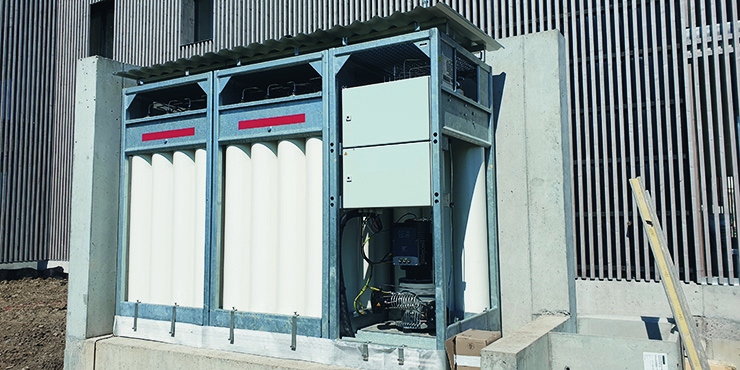Revolutionary energy storage

With the power-to-gas concept (P2G), EKZ is setting an important milestone for Switzerland's power supply in winter.
The apartment buildings in Seebrighof store solar power in the form of hydrogen. Dr. Martin Nicklas, Head of Energy Contracting at EKZ, explains the revolutionary power-to-gas concept: “On summer days, the solar system on the roof of the Seebrighof will produce more electricity than the residents can use. The so-called power-to-gas plant turns this into hydrogen. In winter the energy requirement is higher. Then the stored hydrogen is converted into energy. Around 55 percent of this is used to generate electricity in the system’s fuel cells. The remaining 45 percent of the energy escapes as waste heat, which is used to heat the building. ” The hydrogen is produced from tap water that is processed directly in the plant. Oxygen is created as a quasi waste product, which escapes into the ambient air. This is environmentally friendly because in winter the hydrogen is converted back into water and renewable energy with oxygen from the air. This closes the cycle. The system only uses locally produced solar power for production, and the public power grid is relieved.
EKZ as a pioneer
With a battery in the house, short-term fluctuations in solar power production in the summer are absorbed and, for example, solar power is stored for the night. The P2G system constantly converts the excess remaining free into hydrogen. As a result, it can be implemented more cost-effectively and operated more efficiently. For Nicklas, EKZ is taking on a pioneering role in the conversion to renewable energy supply: “For the first time in Switzerland, a P2G system is being implemented that can also be used cost-effectively in other properties of different sizes – even in existing buildings. With the system, we are testing the potential of seasonal energy storage from solar power for the winter. ” There are a few properties with hydrogen systems in Switzerland, including in the canton of Zurich. The difference in the project in the Seebrighof is the standardized concept, which can be easily and inexpensively applied to other buildings.
Power-to-gas system
But it gets even better: thanks to the power-to-gas system, most of the solar power can be used locally. The electrical efficiency of the P2G system is around 30 to 35 percent across all processes. The rest is generated as waste heat, which is used for hot water heating in summer and for heating in winter. Would you be able to supply yourself with energy completely independently at the Seebrighof? – «This would be technically possible and is already being done in this way in individual properties. However, this would be very costly and was therefore not the aim of this project. “
Safe hydrogen storage
Appropriate safety precautions must be taken when storing flammable and potentially explosive gases such as natural gas or hydrogen. These measures are checked by the authorities to ensure safe installations. Hydrogen is usually stored outdoors, with any leakage gas quickly volatilizing and thus preventing an explosive mixture. In the current case, according to Nicklas, the H2 is stored in commercially available gas cylinders that fully meet Swiss safety standards and norms.
When is a P2G system worthwhile?
The answer depends on many factors and must always relate to the specific building project and the requirements of the client, as Nicklas explains: “The fundamental question is how often the hydrogen storage tank can be charged per year. Because with each charging cycle, the system generates a contribution margin that contributes to amortization. We are also testing this potential with the system and are further developing the concept accordingly. ” The client of the Seebrighof is also demonstrating a pioneering spirit with the project. In this way, she does not only have the system installed from a purely monetary point of view. One would like to lead the way here and make a contribution to reducing the supply gap in winter – making society more independent of energy imports from fossil sources. The facility at Seebrighof can be financed well thanks to its cost-effective implementation, says Nicklas. She makes a significant contribution to research into seasonal storage technologies: “How economically effective the technology is is the subject of our investigations. In the next few years, however, we expect another significant price reduction on the hydrogen market, which could give the technology a boost.
Energy strategy 2050
In the Federal Council’s Energy Strategy 2050, storage technologies based on gases and liquids have a high priority. With the first standardized power-to-gas system, EKZ has reached an important milestone that could serve as an example for future developments. Nicklas concludes: “If we want to fully feed heat and power supply as well as mobility with renewable energy sources, we need efforts in all areas. Hydrogen as a storage medium can help to defuse the challenges of power supply in winter ».
